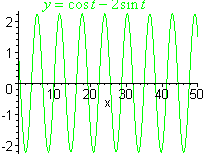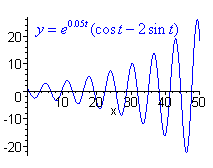3.2: Complex Roots of the Characteristic Equation
( \newcommand{\kernel}{\mathrm{null}\,}\)
We have already addressed how to solve a second order linear homogeneous differential equation with constant coefficients where the roots of the characteristic equation are real and distinct. We will now explain how to handle these differential equations when the roots are complex. The example below demonstrates the method.
Solve
y″−4y′+13y=0.
Solution
As before we assume that y=ert is a solution. We have
y′=rerty″=r2ert.
Substituting back into the original differential equation gives
r2ert−4rert+13ert=0
r2−4r+13=0 dividing by ert.
This quadratic does not factor, so we use the quadratic formula and get the roots
r=2+3i and r=2−3i
We can conclude that the general solution to the differential equation is
y=a1e(2+3i)t+a2e(2−3i)t=a1e2te3it Using the rule of exponents =e2t(a1e3it+a2e−3it) Factoring out the e2t.
Although this gives the general solution, it it not satisfactory since the solution involves complex exponents. To deal with this we use Euler's formula
eiq=cosq+isinq.
This gives
y=e2t[a1(cos(3t)+isin(3t))+a2(cos(−3t)+isin(−3t)).]
Since the cosx is an even function and sinx sin x is an odd function, we get
y=e2t[a1(cos(3t)+isin(3t))+a2(cos(3t)−isin(3t))]
or
y=e2t[(a1+a2)cos(3t)+(a1−a2)isin(3t)].
Finally let
c1=a1+a2andc2=i(a1−a2)
and we get
y=e2t[c1cos(3t)+c2sin(3t)].
In general if
ay″+by′+cy=0
is a second order linear differential equation with constant coefficients such that the characteristic equation has complex roots
r=l+miandr=l−mi
Then the general solution to the differential equation is given by
y=elt[c1cos(mt)+c2sin(mt)]
Solve
y″−10y′+29=0given y(0)=1,y′(0)=3
Solution
The characteristic equation is
r2−10r+29=0
which has roots
r=5+2iandr=5−2i.
The general solution is
y=e5t[c1cos(2t)+c2sin(2t)].
We use the initial values to find the constants. Plug in y(0)=1
1=1[c1(1)+c2(0)]
so that c1=1. We have
y′=5e5t[cos(2t)+c2sin(2t)]+e5t[−2sin(2t)+2c2cos(2t)].
Plugging in y′(0)=3
3=5[1+0]+1[0+2c2]=5+2c2.
Hence c2=−1.
The final solution is
y=e5t[cos(2t)−sin(2t)].
Let's investigate the graphs of solutions for the general solutions in Equation ???
- For l=0, the graph is periodic.
- For l>0, the amplitude increases exponentially
- For l<0, the amplitude approaches 0 exponentially.
The three types are pictured below.


Contributors and Attributions
- Larry Green (Lake Tahoe Community College)
Integrated by Justin Marshall.


